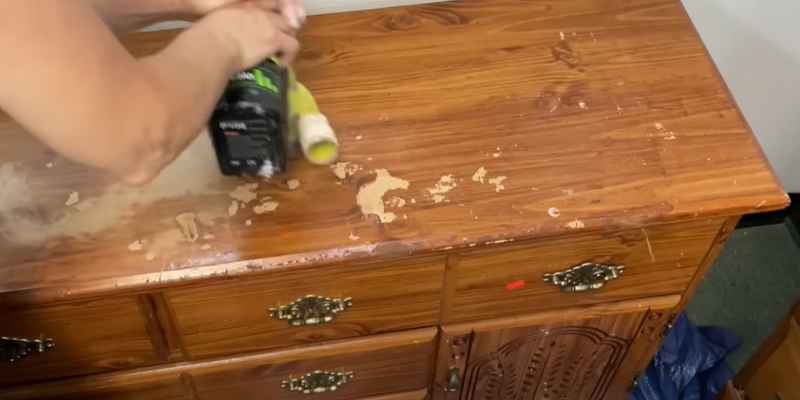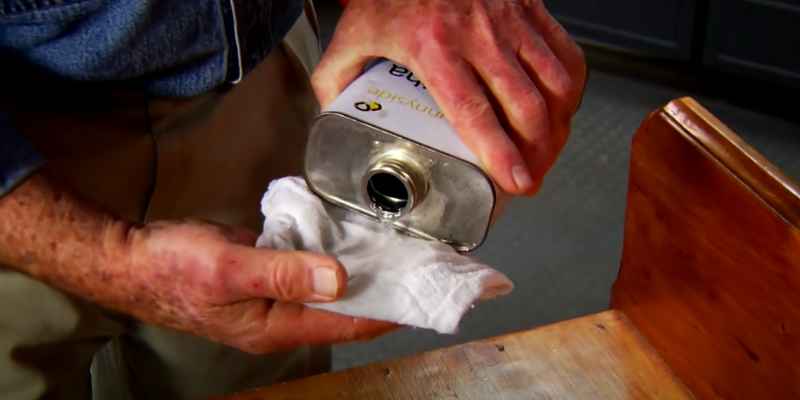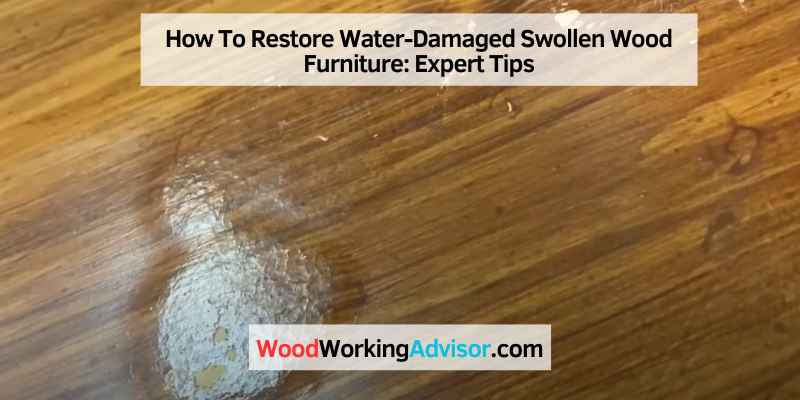To fix water-damaged and swollen wood furniture, follow these steps: assess the damage, dry the furniture, sand the affected areas, and apply a wood conditioner or finish to restore its original appearance. Water damage on wood furniture is a common problem that can occur due to various reasons like spills, leaks, or high humidity levels.
If not addressed promptly, it can lead to swelling, warping, or permanent damage to the piece. The good news is that with the right approach, it is possible to fix water-damaged swollen wood furniture and restore its beauty. This article will provide you with the necessary steps to bring your furniture back to its original condition.
Read on to learn more.
Assessing The Damage
Discover effective strategies for fixing water-damaged swollen wood furniture. Learn how to assess the damage and take the necessary steps to restore your furniture to its former glory.
Identifying Water Damage
Before you can fix water-damaged swollen wood furniture, you need to first assess the extent of the damage. This step is crucial as it will help you determine the appropriate course of action and the materials needed for the repair process.
To begin, identify the areas that have been affected by water damage. Look for signs such as dark stains, discoloration, or warping. These are indications that the water has penetrated the surface and caused damage to the wood.
Inspect the furniture thoroughly, paying attention to any changes in texture or appearance. This could include peeling or flaking paint, swollen or cracked wood, or mold and mildew growth. These visual cues will give you a better understanding of the extent of the damage.
Inspecting For Structural Integrity
Once you have identified the water damage, it is crucial to inspect the furniture for structural integrity. This step will help you determine if the piece of furniture can be salvaged or if it needs to be replaced entirely.
Begin by checking for any signs of mold or rot. These are clear indications that the water damage has compromised the structure of the wood. In such cases, it may be necessary to replace the affected areas or consider replacing the entire piece.
Next, examine the joints and connections of the furniture. Look for any signs of weakness or separation. Water damage can weaken the glue or screws holding the furniture together, which can lead to instability and further damage. If you find any issues, it is important to address them before proceeding with any repairs.
In addition to examining the joints, inspect the overall stability of the furniture. Test it by gently applying pressure to different parts of the piece. If there is any noticeable wobbling or movement, it may indicate structural damage that needs to be repaired before addressing the water damage.

Drying The Furniture
If your wood furniture has been damaged by water and is swollen, follow these steps to fix it. Begin by carefully drying out the furniture to prevent further damage and restore its original shape.
Removing Excess Moisture
Wood furniture can retain a significant amount of moisture after being exposed to water damage. To ensure effective drying, it is crucial to begin by removing any excess moisture. Start by carefully placing the furniture on an elevated surface in a dry area. Using absorbent towels or cloths, gently blot the surface of the furniture, paying attention to areas that are visibly damp. Remember to change the towels frequently to prevent reabsorption of the moisture. Avoid rubbing the wood, as this can potentially damage the finish.
Utilizing Dehumidifiers And Fans
To expedite the drying process, it is highly recommended to employ the use of dehumidifiers and fans. Dehumidifiers are effective at extracting moisture from the air, helping to reduce the overall humidity level in the surrounding environment. Place one or more dehumidifiers near the water-damaged furniture, ideally in a closed room. This will create a controlled drying atmosphere and maximize efficiency. Additionally, strategically positioning fans around the furniture will promote air circulation, aiding in the evaporation of excess moisture.
Enhancing The Drying Process
Providing adequate ventilation is crucial when drying water-damaged wood furniture. Open windows and doors to allow fresh air to circulate in the room. This will help to disperse the moisture and facilitate the drying process. If weather conditions permit, positioning the furniture outdoors in a shaded area can also be beneficial. However, direct sunlight should be avoided, as it can lead to further damage and discoloration of the wood.
Monitoring Progress
Regularly monitor the progress of drying to ensure that it is occurring effectively. Check the furniture’s surface for any signs of remaining moisture, such as darkened spots or a cool touch. You can also use a moisture meter to determine the moisture content of the wood. As the drying process advances, you should notice a decrease in the moisture levels. Patience is key during this step, as thorough drying may take several days or even weeks, depending on the extent of the water damage.
Checking For Mold
Water damage can create favorable conditions for mold growth. As you dry the furniture, be vigilant for any signs of mold or mildew. Inspect the corners, crevices, and undersides of the furniture, as these areas are particularly prone to mold development. If you detect any mold, it is crucial to address the issue promptly. Use a mixture of water and vinegar to gently clean the affected areas, ensuring you wear protective gloves and a mask. By attending to mold promptly, you can prevent it from spreading and causing further damage to your beloved wood furniture.
Treating Mold And Mildew
When water damage strikes wooden furniture, it’s not uncommon for mold and mildew to start growing on the damp surfaces. Besides causing an unpleasant odor, mold and mildew can also pose health risks if not treated promptly and properly. In this section, we will discuss how to identify signs of mold and mildew and apply appropriate cleaning agents to get rid of them.
Identifying Signs Of Mold And Mildew
To effectively treat mold and mildew on water-damaged wooden furniture, it is crucial to first identify their presence. Here are some signs to look out for:
- Musty odor: A musty smell is a strong indication that mold and mildew may be present on your wooden furniture. Trust your nose and be attentive to any unusual odors.
- Discoloration: Mold and mildew often cause dark or black spots on the surface of the wood. These spots may appear fuzzy or powdery.
- Visible growth: In severe cases, you may notice visible patches of mold or mildew growing on your furniture. This is a clear sign that action needs to be taken immediately.
Applying Appropriate Cleaning Agents
Once you have identified the presence of mold and mildew on your water-damaged wooden furniture, it’s time to tackle the issue head-on. Cleaning agents that effectively combat mold and mildew include:
| Cleaning Agent | Usage |
|---|---|
| Vinegar | Combine equal parts vinegar and water in a spray bottle. Spray the affected areas and let it sit for about an hour. Scrub gently with a soft brush and wipe clean. |
| Bleach | Mix one part bleach with three parts water. Apply the solution to the affected areas using a sponge or cloth. Leave for 10 minutes and rinse with clean water. Proper ventilation is essential when working with bleach. |
| Hydrogen peroxide | Dilute hydrogen peroxide with water in a 1:1 ratio. Apply the mixture to the mold and mildew using a cloth, sponge, or spray bottle. Allow it to sit for 15 minutes before wiping clean. |
Remember to wear appropriate protective gear, such as gloves and a mask, while cleaning mold and mildew. Additionally, always test the cleaning solution on a small, inconspicuous area of the furniture before applying it to the entire surface.
By proactively identifying and effectively treating mold and mildew, you can salvage your water-damaged wooden furniture and prevent further damage. Keep in mind that prompt action is essential to ensure the longevity and beauty of your cherished pieces.
Repairing Swollen Wood
Repairing swollen wood furniture after water damage is a simple process that involves gently drying the wood, sanding down the swollen areas, and applying a fresh coat of protective finish to restore the furniture’s original beauty.
If you have water-damaged swollen wood furniture, don’t worry! There are effective ways to repair it and restore its original shape. In this section, we will discuss two techniques: using moisture removal and applying heat. These methods can help you salvage your beloved furniture and prevent further damage.
Using moisture removal techniques
The first step in repairing swollen wood furniture is to remove the excess moisture from the affected area. This can be done using various techniques, depending on the severity of the damage. Here are a few options to consider:
1. Absorbent materials: Place absorbent materials like paper towels or silica gel packets on the swollen wood surface. These materials will soak up the moisture and gradually reduce the swelling. Replace them regularly until the wood starts to dry out.
2. Desiccants and dehumidifiers: For more severe cases, you can use desiccants or dehumidifiers to speed up the drying process. These devices help to extract moisture from the air and promote faster evaporation. Place them in the room with the damaged furniture to create a dry environment.
3. Fans and air circulation: Another effective way to remove moisture is by using fans and promoting air circulation. Direct a fan towards the swollen wood furniture to enhance evaporation. Open windows and doors to allow fresh air to circulate, aiding the drying process.
Applying heat to restore shape
Once you have successfully reduced the moisture content, the next step is to restore the shape of the swollen wood furniture using heat. Heat helps to expand the wood fibers and allows them to return to their original position. Here’s how to do it:
1. Hairdryer or heat gun: Use a hairdryer or heat gun on a low heat setting to apply gentle heat to the swollen area. Keep the heat source at a safe distance and continuously move it back and forth to prevent any damage. Remember to stay patient as this process may take some time.
2. Hot water treatment: For larger or more stubborn swellings, you can try the hot water treatment. Boil water and pour it carefully onto a cloth. Place the cloth on the swollen wood and allow the heat to penetrate the fibers. This method can be particularly effective for wooden table legs or chair arms.
3. Steam application: Steam can also be used to restore shape. Hold a steam iron close to the swollen wood surface, making sure not to touch the wood directly. The steam will penetrate the fibers and slowly reduce the swelling. Once again, patience is key as you wait for the wood to regain its original form.
Remember to assess the condition of the wood before proceeding with any repair techniques. If the damage is extensive or irreversible, it may be necessary to seek professional help or consider replacing the furniture. By following these tips, you can take an active role in restoring your water-damaged swollen wood furniture and extend its lifespan.

Refinishing The Furniture
Learn how to repair water-damaged, swollen wood furniture with our step-by-step guide. Easily refinish your furniture and restore its beauty using simple methods and supplies.
Sanding And Smoothing The Surface
When it comes to refinishing water-damaged and swollen wood furniture, one of the first steps you’ll need to take is sanding and smoothing the surface. Sanding helps to remove the damaged layers, leveling the surface and preparing it for a new finish or stain.
Here’s How You Can Sand And Smooth The Surface:
- Start by gathering the necessary tools: a medium-grit sandpaper (around 150 grit), a sanding block or an orbital sander, and a dust mask.
- Begin sanding the damaged area using even strokes, following the grain of the wood. Be sure to sand off any rough or raised edges until the surface feels smooth to the touch.
- Keep in mind that you should not put excessive pressure on the sander or sandpaper, as this can further damage the wood. Instead, let the tool do the work for you.
- Periodically stop sanding to clean the surface and remove any dust or debris. This will help you see the progress and ensure a smooth finish.
- Once you have sanded the entire surface, you can switch to a finer-grit sandpaper (around 220 grit) to achieve an even smoother result.
- Remember to wear a dust mask throughout the sanding process to protect your lungs from fine wood particles.
Applying A New Finish Or Stain
After sanding and smoothing the surface, the next step in refinishing water-damaged wood furniture is applying a new finish or stain. This will not only enhance the appearance of the furniture but also protect it from future damage.
Follow These Steps To Apply A New Finish Or Stain:
- Clean the sanded surface using a soft cloth or vacuum to remove any dust or debris.
- If you’re applying a stain, use a brush or cloth to evenly distribute the stain over the wood. Work in the direction of the grain, allowing the stain to penetrate the wood for the recommended time.
- If you’re applying a new finish, such as varnish or polyurethane, follow the manufacturer’s instructions for application. Typically, you’ll need to use a brush or cloth to apply thin, even coats, allowing each coat to dry before applying the next.
- Make sure to apply the finish or stain in a well-ventilated area to avoid inhaling fumes.
- After the final coat is applied and dried, lightly sand the surface with a fine-grit sandpaper for a smooth and polished finish.
- Clean the surface once again to remove any dust or debris.
By following these simple steps, you can successfully refinish water-damaged and swollen wood furniture, restoring its beauty and prolonging its lifespan. Remember, with a little patience and effort, your furniture can regain its charm and become a focal point in your home once again.
Conclusion
To conclude, repairing water damaged swollen wood furniture is not as daunting as it may seem. By following the steps mentioned in this blog post, you can restore the beauty and functionality of your beloved furniture. Remember to act quickly, properly dry the wood, and go through the necessary repairs.
By taking these measures, your furniture will look as good as new and last for years to come.


